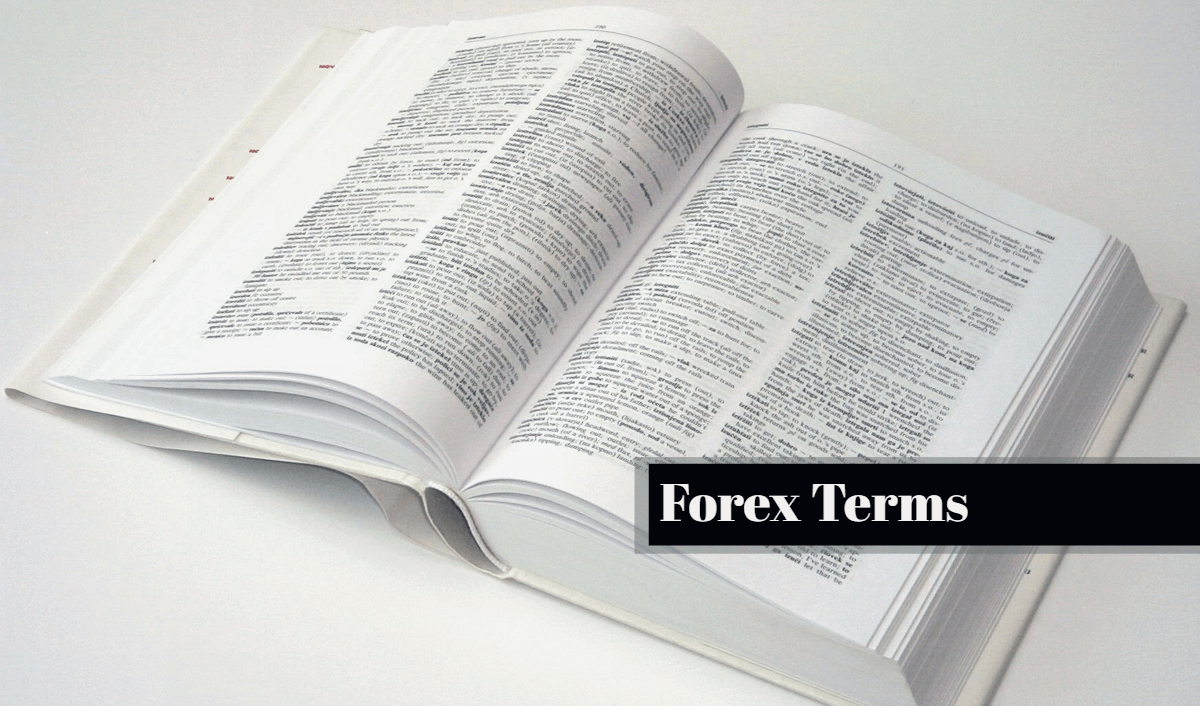
Navigating the Forex market can be difficult, especially when you do not understand its special trading language.
When you do not understand the common Forex trading terms, your journey to successful Forex trading may be hindered.
In this guide, 45 of the most frequently used Forex terms, are explained simply.
Basic Forex Terms for Beginners
To immediately get started, here’s a simple table listing the key Forex terms explained in this guide:
| Forex Terms | Definition |
|---|---|
| Forex (Foreign Exchange) | The global marketplace for trading currencies. |
| Exchange Rate | The price of one currency in terms of another. |
| Currency Pairs | The pairing of two currencies in a Forex trade. |
| Base Currency | The primary currency in a currency pair. |
| Quote Currency | The secondary currency in a currency pair. |
| Forex Broker | A company that provides access to the Forex market. |
| Scalping | A short-term trading strategy for making small profits. |
| Day Trading | Opening and closing positions within the same trading day. |
| Swing Trading | Holding positions for several days or weeks to profit from price swings. |
| Economic Calendar | A tool that tracks important economic events. |
| Bid and Ask Price | The price at which you can buy or sell a currency. |
| Spread | The difference between the bid and ask price. |
| Pip | The smallest change in value between two currencies. |
| Leverage | Using borrowed money to amplify returns. |
| Carry Trade | Borrowing in a low-interest rate currency and investing in a higher-interest rate currency. |
| Equity | The value of your trading account. |
| Market Order | Buying or selling at the current market price. |
| Limit Order | Setting a specific price at which to buy or sell. |
| Stop-Loss Order | A predetermined price to limit losses. |
| Take-Profit Order | A predetermined price to secure profits. |
| Risk Management | Strategies to protect your trading capital. |
| Margin | The amount of money set aside for a trade. |
| Margin Call | A warning when your account balance falls close to the margin. |
| Candlestick | A charting method to represent price movements. |
| Fibonacci Retracement | Levels used to identify potential reversal points. |
| RSI (Relative Strength Index) | An indicator of overbought or oversold conditions. |
| MACD (Moving Average Convergence Divergence) | An indicator to spot changes in trend strength and direction. |
| Moving Average | A smoothed representation of price data. |
| Moving Average Cross | A signal generated when two moving averages cross. |
| Stochastic Oscillator | An indicator of momentum and overbought/oversold conditions. |
| Fundamental and Technical Analysis | Two approaches to making trading decisions. |
| Bull Market | A rising market. |
| Bear Market | A falling market. |
| Ichimoku Cloud | A tool for trend analysis. |
| Volatility | The degree of price fluctuations in the market. |
| Volatility Index (VIX) | A measure of market volatility. |
| Hedging | Using one trade to offset the risk of another. |
| CFD (Contract for Difference) | A contract that speculates on price movements. |
| Lot Size | The size of a trading position. |
| Lot Size Calculator | A tool to determine position size. |
| Trend | The general direction of a currency pair’s price movement. |
| Resistance Level | A price level where a currency struggles to rise above. |
| Support Level | A price level where a currency tends to bounce back up. |
| Relative Vigor Index (RVI) | An indicator of trend strength. |
| Fibonacci Extensions | Levels used to estimate future price movements after a retracement. |
1# Forex (Foreign Exchange)
At its core, Forex is the global marketplace where you trade currencies. It’s like a giant digital bazaar where one currency is exchanged for another.
Imagine you’re traveling to Europe, and you need to exchange your US Dollars (USD) for Euros (EUR). You’re essentially doing a mini Forex trade right there!
2# Exchange Rate
This is the price of one currency in terms of another. It tells you how much of the quote currency you need to buy one unit of the base currency. For example, if the EUR/USD exchange rate is 1.20, it means you need 1.20 USD to buy 1 Euro.
3# Currency pairs
A Forex quote is the price of one currency in terms of another currency. You buy one currency by selling another. For example, the price of a euro could be $1.18. We use examples to explain how you can easily read forex pairs.
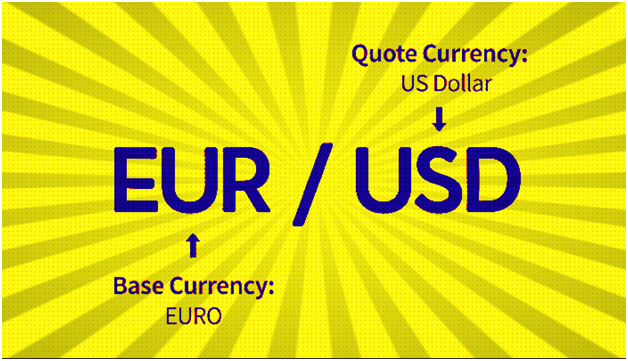
As the image above shows, the first mentioned currency is the base currency. The currency behind the line is the quote currency. For example, if the price for EUR/USD is 1.15, that means you have to pay $1.15 to get 1 Euro.
4# Base Currency
Imagine you’re planning a trip from the US to Europe. The base currency is like your home currency – in this case, the US dollar (USD). It’s the currency you use as a reference point when you’re in a foreign country. So, if you see EUR/USD trading at 1.20, it means 1 Euro is worth 1.20 US dollars. In this pair, USD is the base currency.
5# Quote Currency
Now, think of the quote currency as the foreign currency you’re exchanging your dollars for when you travel. In the EUR/USD pair, EUR is the quote currency. So, if you want to buy 100 Euros when the rate is 1.20, you’ll pay 120 US dollars.
6# Forex Broker
A Forex broker is a company that acts as an intermediary between you and the interbank Forex market. They provide you with a trading platform and access to the market. Popular brokers include Forex.com, IG, and OANDA.
Read also! How to Choose the Right Forex Broker
7# Scalping
Scalping is a short-term trading strategy where you aim to make small profits from tiny price movements. Scalpers make lots of quick trades throughout the day, sometimes holding a position for just a few seconds. It’s like catching minnows in a stream, but those minnows add up!
8# Day Trading
This Forex term means opening and closing positions within the same trading day. Day traders don’t leave positions open overnight, reducing the risk from overnight market moves. It’s intense and requires your full attention during trading hours.
9# Swing Trading
Swing traders, on the other hand, hold positions for several days or even weeks. They aim to catch “swings” in the market, profiting from short to medium-term price movements. It’s like catching bigger waves in the sea.
Read also! Types of Forex Traders
10# Economic Calendar
Think of an economic calendar as your GPS for Forex trading. It’s a tool that tells you when important economic events, like interest rate decisions or GDP reports, are scheduled to happen. These events can significantly impact currency prices.
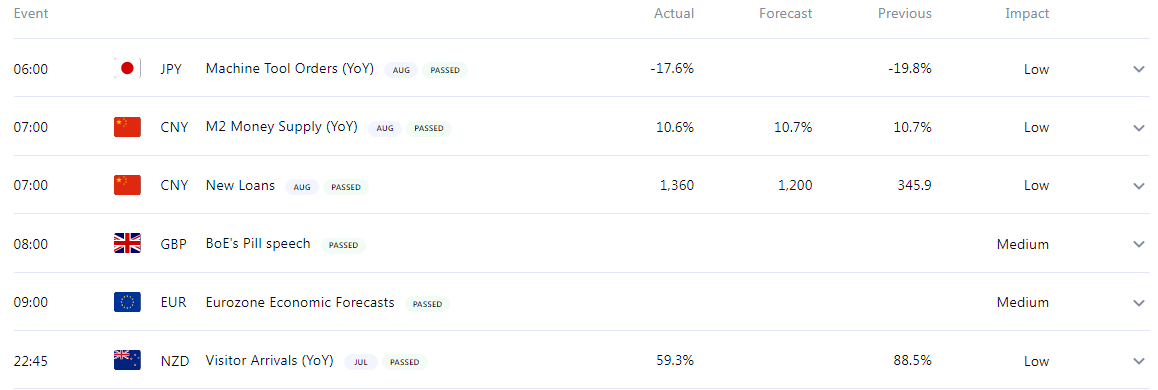
For example, if the U.S. releases strong job data, the USD may rise. So, check the calendar to avoid surprises.
11# Bid and Ask price
The bid price is the price at which a broker is willing to a buy currency. The ask price is the price at which a trader is willing to sell his currency. The difference between these two prices is the spread.
12# Spread
Spread is the difference between the bid price (buy) and ask price (sell). Forex brokers often do not charge a commission, but make their money through spreads.
Spreads may vary depending on the size of your purchase, the currency you are trading in or the volatility of the market at the time.
Suppose the bid price of EUR/USD is 1.0670 and the ask price is 1.0672, then the spread is 2 pips.
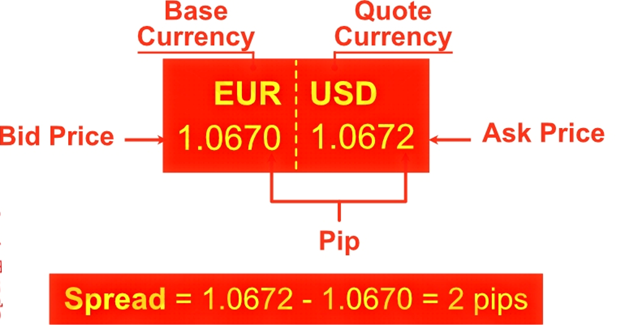
13# Pip
This Forex term literally means a percentage in point (pip). A pip is the unit of measurement used by forex investors to define the smallest change in value between two currencies. This is a move to the fourth decimal place in a forex quote.
Suppose the price of EUR/USD is 1.0672 and the price rises to 1.0674. This is an increase of 2 pips. These 2 pips means that the value of the euro has increased against the dollar. You get more dollars for the same euro. So a pip is 1/100th of 1%. This number of decimals protects investors from big losses.
14# Leverage
Leverage is using borrowed money to multiply returns. Forex trading is characterized by high leverage. Traders use these leverages to strengthen their position.
For example, if you invest $100 with a leverage of 1:30, you borrow $2,900 from the broker and therefore have a position of $3,000.
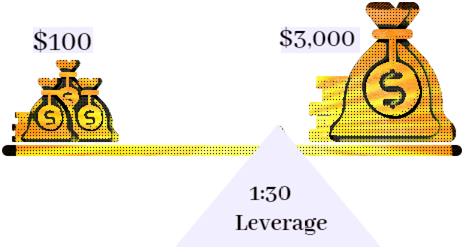
Naturally, this involves major risks.
When you use a very high leverage that your margin is less than 10x and 20x your costs, your odds of losing start to grow very quickly.
15# Carry Trade
Imagine you have a magic money tree that grows cash while you wait. That’s a bit like a carry trade. You borrow money in a currency with a low-interest rate (e.g., Japanese Yen) and invest it in a currency with a higher interest rate (e.g., Australian Dollar). You earn the difference as profit. The longer you wait, the more you make.
16# Equity
This is your account’s value. It’s like the money you have in your wallet. It changes as your trades go up and down. If you start with $1,000 and your trades make you $200, your equity is now $1,200. It’s crucial to monitor your equity because it determines how much you can trade and helps you avoid overleveraging your positions.
17# Market Order
Think of a market order as buying something online with one click. You’re buying at the current market price. Let’s say EUR/USD is trading at 1.20, and you hit “buy” – you’re getting it for 1.20.
18# Limit Order
Imagine you want to buy a new smartphone, but you only want it if the price drops to a certain level. A limit order is like setting a price alert. You tell your trading platform, “I’ll buy EUR/USD, but only if it goes down to 1.18.” When the rate hits 1.18, your order automatically kicks in.
19# Stop-Loss Order
Think of a stop-loss as a safety net. You set a price at which you’re willing to sell a currency if it starts going the wrong way. For example, you buy EUR/USD at 1.20, but you don’t want to lose too much. You set a stop-loss at 1.19. If the rate falls to 1.19, your trade is automatically closed to limit your losses.
20# Take-Profit Order
This is like setting a goal. You’ve bought EUR/USD at 1.20, and you think it’ll go up to 1.22. You set a take-profit order at 1.22. If the rate reaches that level, your trade closes automatically, locking in your profit.
21# Risk Management
This is like wearing a seatbelt when you’re driving. It’s all about protecting yourself. In Forex, it means setting stop-loss orders, diversifying your trades, and not risking too much of your equity on a single trade. Good risk management is like the brakes on your trading car; it keeps you from crashing. It’s about playing it safe in an unpredictable market.
22# Margin
If you trade with a leverage of 1:30, you can lose all your money if the price drops 30%. Fluctuations are, as it were, amplified 30x. If you trade without leverage, you can only lose all your money if the price were to become zero. Because you can lose all your money, margin comes into play.
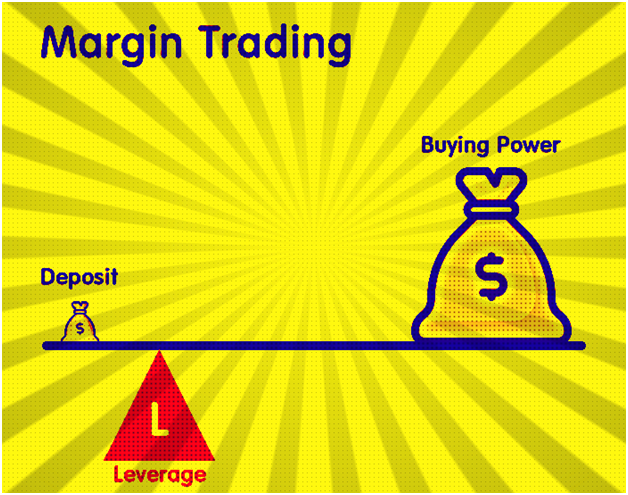
Margin is the money set aside in a Forex trading account. Margin gives the broker certainty that the investor will continue to be able to meet his obligations, even if a transaction does not go according to plan. The amount of margin an investor should have depends on the investments and leverage.
If things went perfectly, your trade would be automatically closed once you’ve lost all your money. Because the price can suddenly drop a lot, your trade can sometimes not be closed in time and you therefore lose more than what you have. Margin is there to absorb this difference.
23# Margin Call
Now, let’s talk about margin call. Think of it as a warning from your broker. It’s like when your bank calls to say you’re running low on funds. In Forex, if your losses get too close to the amount you initially put in your account (your margin), your broker may ask you to deposit more money to cover potential losses.
24# Candlestick
Candlesticks are almost always used in forex trading. These are easier to read than any other kind of chart in forex. A candlestick indicates the course of the price in a certain time. For example, you can set this to 10 minutes.
The top point of the candlestick is the highest point the price has reached in that time frame, in this case within 10 minutes. The bottom point is the lowest point the price has reached.
If the candlestick is green, then the opening, the beginning of the 10 minutes, is the bottom point of the thick bar and the close is the top point of the thick bar. With a red candlestick this is exactly the other way around.

The thin lines are therefore the extreme prices in this period. The top and bottom of the bar are the opening and closing prices (depending on the color).
25# Fibonacci Retracement
Fibonacci retracement levels are like secret support and resistance zones. They’re based on a mathematical sequence and often used by traders to identify potential reversal points in a price trend. Picture a bungee jumper bouncing back up after diving off a bridge – those bounce-back points are like Fibonacci retracement levels.
26# RSI (Relative Strength Index)
RSI is a momentum indicator that tells you if a currency pair is overbought or oversold. Think of it as asking, “Are we there yet?” during a road trip. If RSI is above 70, it might mean the price is overbought, and a reversal could be coming. If it’s below 30, it might be oversold, suggesting a potential bounce back.
27# MACD (Moving Average Convergence Divergence)
The MACD helps traders spot changes in a trend’s strength and direction. It’s like watching two cars on a road – the fast one (short-term moving average) and the slow one (long-term moving average). When they cross, it can signal a shift in momentum.
28# Moving Average
Moving averages are like smoothing out a bumpy road. They average out past price data to create a single flowing line on your chart. Traders use them to identify trends and potential reversal points.
29# Moving Average Cross
Think of this like a traffic signal. When two lines on your Forex chart cross, it can be a signal to buy or sell. There are two types of moving averages: Simple and Exponential.
For example, if the shorter-term moving average (let’s say it’s a 50-day average) crosses above the longer-term one (say 200-day), it can signal an upward trend. This might be a good time to buy.
30# Stochastic Oscillator
This tool measures the momentum of a currency pair. It ranges between 0 and 100 and helps identify overbought and oversold conditions.
If the Stochastic Oscillator is above 80, it indicates that the currency pair might be overbought and due for a correction. If it’s below 20, it might be oversold and due for a bounce-back.
31# Fundamental and Technical Analysis
Traders use these two approaches to make decisions. Fundamental analysis looks at economic indicators and news events. Technical analysis uses charts and patterns to predict future price movements.
Read also! Which Type of Forex Analysis is Best?
32# Bull Market
A bull market is a market where a currency is rising. This is often the result of economic growth or more confidence in the economy.
33# Bear Market
A bear market is the opposite of a bull market. In a bear market, a currency drops. This indicates a downward market trend and is often the result of an economic crisis, loss of confidence or, for example, less confidence in currencies.
34# Ichimoku Cloud
This is like having a weather forecast for your trading. It provides several lines on your chart, with the cloud (or ‘Kumo’) being the most distinctive. If the price is above the cloud, it’s a sunny day (bullish). Below the cloud, think of it as a cloudy day (bearish). The cloud’s thickness indicates market volatility.
35# Volatility
This measures how much a currency pair’s price fluctuates. Major economic events, like interest rate changes, can increase volatility. Think of it as a rollercoaster ride; high volatility means bigger price swings.
36# Volatility Index (VIX)
The VIX measures market volatility. It’s often called the “fear gauge” because it reflects investors’ sentiment.
When the VIX is high, it indicates that traders are nervous, and markets are turbulent. Low VIX values suggest calm and confidence.
Traders use the VIX to assess market risk and adjust their strategies accordingly.
37# Hedging
Imagine you’re a farmer and you’re worried about the price of wheat falling. So, you sell some wheat futures to protect your profits.
In Forex, it’s like having an insurance policy for your trades. You make one trade to offset the risk of another.
Let’s say you’re long on the EUR/USD, but you’re worried about sudden market volatility. You could open a short position on the same pair to protect your investment. If the market goes up, your long position profits, and if it goes down, your short position offsets the loss.
38# CFD
A contract for difference (CFD) is a contract that allows investors to speculate on currency price movements without actually owning the underlying asset. If you expect the euro to increase in value against the dollar, you can buy a CFD for the EUR/USD. So if you ‘buy’ dollars using a CFD, you don’t own dollars, you only speculate on the price.
39# Lot Size
In Forex, trades are done in specific lot sizes. There are three common lot sizes:
- Standard Lot: 100,000 units of the base currency.
- Mini Lot: 10,000 units of the base currency.
- Micro Lot: 1,000 units of the base currency for smaller traders.
40# Lot Size Calculator
Choosing the right lot size is vital in Forex. It determines how much currency you’re trading. Lot size calculators help you manage risk by letting you know how much of your trading capital you’re putting at stake.
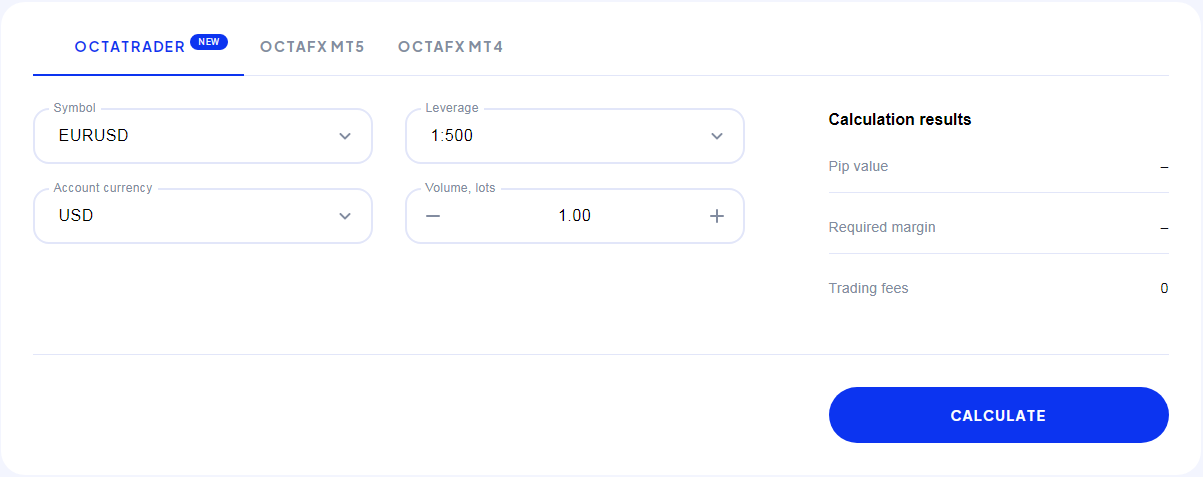
For example, if your account balance is $10,000 and you’re willing to risk 2% on a trade, a lot size calculator will tell you the appropriate position size to stay within your risk tolerance.
41# Trend
Imagine you’re at the beach, and you notice waves rolling in. Forex trends are like those waves – they show you the general direction a currency pair is moving. There are three types: uptrends (going up), downtrends (going down), and sideways trends (moving mostly flat). To spot a trend, look at a currency pair’s price chart over time. Here’s an example:
- Uptrend: If you see a line sloping upwards, like climbing a hill, it’s an uptrend. Example: EUR/USD going from 1.1000 to 1.1500.
- Downtrend: Picture a slide at a playground – that’s a downtrend. Example: USD/JPY falling from 110.00 to 105.00.
- Sideways Trend: This is like a calm sea with small ripples. Prices move within a range, neither up nor down. Example: GBP/USD bouncing between 1.3000 and 1.3200.
42# Resistance Level
Imagine a ceiling. Resistance is like a price level where a currency pair often struggles to break through. It’s like saying, “I can’t go higher!” Traders watch these levels closely, as they can signal potential trend reversals.
43# Support Level
On the flip side, support is like a solid floor. It’s a price level where a currency pair tends to bounce back up. It’s like saying, “I can’t go lower!” Traders also keep an eye on support levels because they can indicate possible reversals.
44# Relative Vigor Index (RVI)
The RVI measures the strength of a trend by comparing closing prices to opening prices. If it’s above 0, it’s a bullish trend; below 0, it’s bearish. Let’s say RVI is above 0 and rising – it’s like a green light for buying. A low RVI suggests the opposite.
45# Fibonacci Extensions
Fibonacci extensions are levels used to estimate where the price might go after a retracement. These levels are based on the Fibonacci sequence, which occurs naturally in many aspects of life.
For example, after a currency pair retraces from a high point, traders often use Fibonacci extension levels to predict potential future highs. For instance, the 161.8% extension suggests the price could move 161.8% of the retracement level.
Conclusion
Phew! That’s a lot to take in, but remember, every pro trader was once a newbie like you. Understanding these basic Forex terms is a fantastic starting point for your trading journey.
Remember, practice and patience are key. Don’t rush into live trading; use demo accounts to hone your skills. Over time, you’ll become more comfortable with these terms and the exciting world of Forex trading.
Happy trading!
